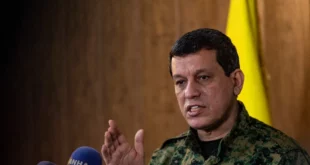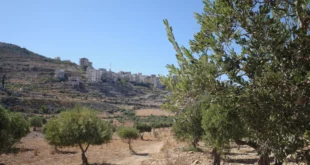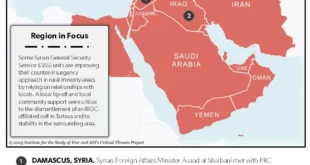The following article was written by Kurdish scholar Himdad Mustafa for the Middle East Media Research Institute (MEMRI). It expresses the hope that the international community can come to an understanding that a regime change in Iran can only come by creating a coalition of Iran’s ethnic “minorities.”
Israel’s imminent strike on Iran, in response to the Iranian ballistic attack on the first of October, could be an opportunity for the peoples of Iran to rise up against the Islamic Republic. However, the key for any “regime change” in Iran is in its ethnic “minorities.” If the whole country rises up, the regime will withdraw its forces from border regions like Kurdistan to central Iran and Tehran. That is the time when the West should support the Kurds, Balochs, and other ethnic groups to topple the regime.
Since the mid-2000s, after a series of violent clashes between the Islamic republic of Iran and the various ethnic groups in the country, Iran’s military and political elites were afraid of a possible “hybrid war” scenario against the Islamic republic. Such a hybrid war would comprise widespread national protests coinciding with an external military attack. This may be the time for it.
For more information and analysis on how a regime change can be brought about by supporting ethnic groups in Iran, see the recent article by renowned Baloch Leader Hyrbyair Marri recently published by MEMRI: MEMRI Daily Brief No. 660, The Baloch Are Not A Minority In Iran, But Rather A Nation Under Iranian Occupation; Chinese And Pakistani Policies Are Catastrophic To The Baloch Nation, October 16, 2024
Below is Himdad Mustafa’s article:
Ethnic Groups Across Iran Have Become A Crucial Force
Understanding Iran’s periphery and the grievances of its ethnic minorities is essential to shaping a strategy for a regime change in Iran.
Iran’s population is estimated at around 87,000,000, roughly half of whom are ethnic Persians that predominantly live in central Iran, the rest being Kurds, Balochs, Azeris, Arabs, Turkmen, Lurs, and Caspian ethnicities. Although the successive regimes in Iran have succeeded in tackling ethnic uprisings, they lost the ideological and political war against minority ethno-nationalisms.
Since the foundation of modern Iran in 1925, there has been little support for the central government or its ideology and politics in the ethnic regions of the country. The state has therefore viewed ethnic minorities and their political struggle for survival as an existential threat to its integrity. Nevertheless, through their growing opposition to the regime’s minority policies and systematic discrimination, ethnic groups across Iran have become a crucial force turning minority politics and ethnic mobilization into an important space of resistance and movement for political change in the country.
The Geopolitical Importance Of Iran’s Ethnic Regions
Three factors have made Iran a key regional player: its geostrategic position, its extensive resources, and its human capital.
Geography plays a key role in Iran’s desire to become a regional power, as is located at a strategic intersection between the Middle East, Central Asia, the Caucasus and the Indian subcontinent, and borders the Caspian and Arabian Seas, and the Sea of Oman.
Through its border provinces, the regime accesses the outside world and its proxies and “colonies” (i.e., Iraq, Lebanon, Syria, and Gaza). Therefore, Iran’s domestic and foreign policies strongly impact the ethnic groups in the border regions. Given that ethnic minorities share strong cultural ties with coethnics in neighboring states, their press for greater self-determination and political autonomy could potentially lead to a unification with their kin. The role of “kin states” in supporting their coethnics morally and materially across the border is therefore of great strategic importance.
Balochistan lies at the mouth of the Strait of Hormuz, which is the world’s most important oil chokepoint because of the large volumes of oil that flow through it. The area has enormous potential to emerge as a regional hub and has become a key part of China’s Belt and Road Initiative (BRI).
Given Iran’s geographic location between the Arabian Peninsula, Central Asia, and South Asia, engaging it within the Belt and Road Initiative framework is essential to the realization of the BRI trade route for China. Particularly the Southern Corridor of the BRI, which will cross Central Asia, Iran, Turkey, and the Balkans. Hence, the ultimate success of the BRI depends to a large extent on Iranian participation and support. Iran’s importance in turn depends largely on the border regions’ security and the political challenges they pose.
Since the mid-2000s, following a series of violent clashes between the regime and the ethnic groups, Iran’s military and political elites have been worried about a possible “hybrid war” scenario that would threaten the regime’s survival in the future. Such a hybrid war would constitute widespread national protests coinciding with an external military attack. In order to tackle this danger, since the early 2010s, Iran has been changing its defensive/deterrent doctrine, adding an offensive dimension by adopting the “forward defense” doctrine, which implies that Iran should fight its opponents outside its borders to prevent conflict inside Iran.
In July 2022, Chief of Staff of the Iranian Armed Forces Major General Mohammad Hossein Baqeri warned against a tough and complicated “hybrid warfare” that the enemies have waged against the Islamic Republic. Therefore, he stressed “the necessity for constant improvement of Iran’s deterrent power,” in order to encounter external “military threats” and internal “security threats” at the same time.[1]
In fact, Iran’s military doctrine of “forward defense” – engaging enemies outside of Iran – demonstrates its vulnerability at home, for Iran worries about losing its strategic “hybrid warfare,” when engaged internally if an anti-regime revolution were to break out across the country. Iranian society and the ethnic conglomerate are very fragile and prone to collapse under a more or less foreign interference combined with internal unrest.
Human Capital
Since Iran is an authoritarian regime and pursues a military expansionist policy abroad, Tehran desperately needs the human capital of the ethnic minorities that constitute half of its population. Iran’s large population has given it the largest pool of military age manpower of any state in the Persian Gulf, but the ethnic divisions within this population present a number of serious political, security, and economic challenges.
The Constitution of the Islamic Republic of Iran requires that all men over the age of 18 serve in the Armed Forces of Iran. At least half of Iran’s regular armed forces are thus composed of troops conscripted from ethnic minorities. However, Persians comprise almost 80 percent of the senior officers due to the army’s distrust of non-Persian ethnic groups.
Furthermore, soldiers are not allowed to serve in their ethnic regions. This is to ensure that the military will not play a divisive role if ethnic tension in Iran increases. However, a major ethnic conflict can lead to defections among the armed forces and negatively impact the effectiveness and morale of the Iranian army. This would be similar to the 1979 protests, when the revolution gained momentum and fighting broke out within some army units between those loyal to the Shah and the supporters of Khomeini. This situation weakened the internal bonds of the military, as many troops refused to follow orders and many conscripts deserted.
Iran’s current military capabilities are thus heavily influenced by its demographics. Iran is by far the most populous Gulf state, giving it a major potential advantage in building up its military forces. At the same time, this manpower base has deep ethnic divisions, and Iran’s ability to manipulate and transform it into military power in service of the government has so far been successful, but it could also play a sabotaging role in an ethnic conflict.
Iran’s ethnic minorities form the majority of the working class. It is worth noting that Iran has particularly been successful in utilizing Azeris in its nation building. Many of them are well integrated into Persian society and are therefore present in all different socioeconomic and political strata (e.g., the Supreme Leader Ali Khamenei is of Azeri descent).
If Iran undergoes significant political unrest, manpower shortages caused by the disintegration of the country will have a serious effect on its economy and military strength. The loss of its territory will simultaneously lead to the loss of its ethnic minorities’ human capital, including almost half of its military personnel.
Natural Capital
Iran’s national wealth comes from its natural resources mostly concentrated in the border regions, which has turned the Islamic Republic of Iran into an economic giant and a strong military power in the Middle East.
Khuzestan province – called Iran’s “Achilles’ heel” – which is predominantly inhabited by Arabs, is Iran’s energy capital as it produces on average over 80 percent of Iran’s oil production and the bulk of its natural gas production.
Despite the amount of revenue generated by the province, Khuzestan suffers from extreme poverty, high unemployment, a lack of water and electricity, and growing health-related issues.
Iranian Azerbaijan has the largest concentration of industry and trade outside of Tehran. Natural gas reserves in the Chalous gas field in the Caspian Sea of northern Iran, which is inhabited by Gilakis and Mazanderanis, could potentially meet almost 50 percent of all European demand for gas for 20 years.
Iranian Kurdistan (called East Kurdistan or Rojhelat by the Kurds) possesses a large variety of mineral reserves estimated to be around eight billion tons, oil reserves and massive surface and underground water resources. The region contains almost 70 percent of Iran’s proven gold reserves, estimated at 340 metric tons. Kurdistan has for decades supplied the economic, agricultural, and industrial sectors in Iran, mainly benefiting the development of the central parts of the country and bringing significant income to the state. This has occurred while the Kurdish region remains among the most economically underdeveloped and deprived areas of Iran. Furthermore, some 15 percent of Iran’s gas reserves are located in Kurdistan’s Ilam province. Ilam Gas Refinery is the main gas supplier to Iraq, which Iran has utilized as yet another political weapon to bring Iraq under its economic and political control.
The Balochistan region, called the “mineral rainbow” of Iran, is where most of the economic mines with reserves of antimony, titanium, copper, and gold are. Fanuj city is estimated to sit on 3.6 billion tons of titanium reserves, the strategic metal of the century.
Areas falling within the provinces of Khuzestan, the Caspian regions, and Kurdistan possess most of Iran’s surface and underground water resources. As the country faces intensified climate change challenges, including severe droughts, the Iranian government has aimed at overcoming water-related crises in the country’s central regions by building dams and water-diversion projects in the peripheral regions of Khuzestan and Kurdistan. Therefore, despite such an abundance of water, the two regions due to the transformation of their water to Persian regions are suffering from a massive water shortage.
The control of such resources has thus never been in the hands of the ethnic minorities, and has instead been controlled by the central authorities and utilized to develop the central regions of Iran and strengthen Iran’s military power to fuel its regional military expansionism. Therefore, despite being home to the bulk of Iran’s natural wealth, the rate of deprivation, poverty, and unemployment is very high in the border regions. This uneven distribution of resources has created long-standing grievances and played a significant role in fueling the ethnic groups’ desire for independence in the impoverished and underdeveloped periphery.
The Iranian state’s economic and developmental approach to natural resources and the mechanisms of extraction and exploitation of these resources in ethnic regions have resulted in extensive environmental destruction, affecting the public health and life expectancy. The ethnic regions have thus become internal “colonies” of the Iranian state, where the minorities and their natural resources are subject to state exploitation and destruction.
Conclusion: Toward A “Periphery Strategy” In Iran
In order to bring about regime change at home and contain Iranian expansionism abroad, Iran needs to be weakened from within. The international community therefore must engage Iran more effectively inside its borders through pursuing a “periphery strategy,” i.e., supporting the ethnic minorities found in its border regions. This will achieve two goals. First, ethnic minorities would finally enjoy the freedom and human rights of which they have been deprived since the early 20th century. Second, this would deprive Iran of human and natural resources it needs to perpetrate its malign expansionism in the Middle East.
An array of democratic ethno-nations in the periphery of Iran would create a “great wall” around the country. This “wall” would stretch from the Kurdish areas of Northern Khurasan to the Persian gulf in the west including Azerbaijan, Kurdistan, and Khuzestan as well as Balochistan in the southeast and would limit Iran’s access to the outside world and consequently end its geostrategic threat regionally and internationally.
 Eurasia Press & News
Eurasia Press & News


